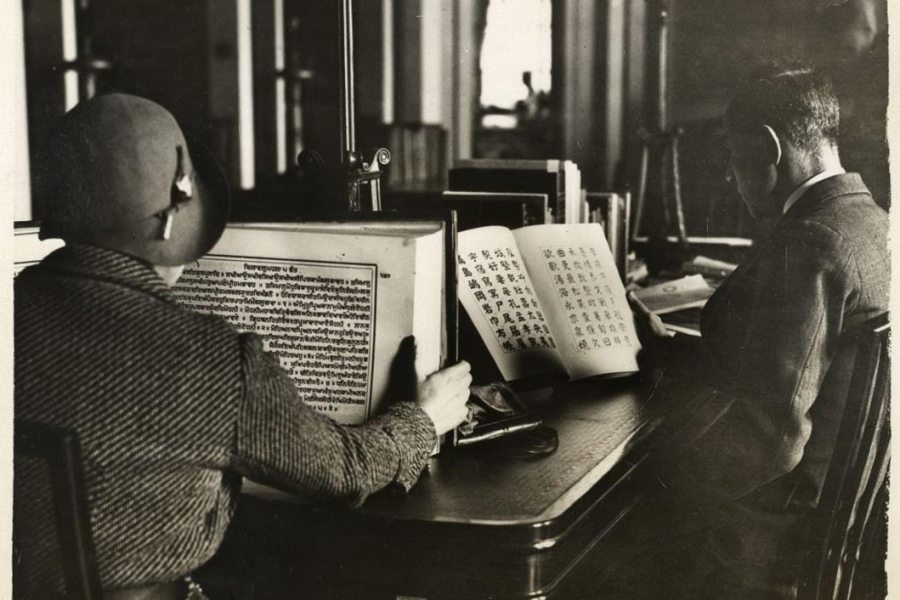‘Since its establishment in 1917, the School has attracted highly gifted scholars with established international reputations…They must have formed the biggest single bunch of eccentrics in Europe.’
This quote, from the former director of SOAS, Sir Cyril Philips (1957–76), summed up the unique nature of the institution he managed for 20 years. Founded as a school for languages, to train specialists for overseas postings, the School of Oriental (and later African) Studies would prove to be a most influential specialist centre for the study of Asia and Africa.
SOAS in Finsbury Circus
To celebrate its centenary year, the School has mounted an exhibition which tells its history from the perspective of its people and spaces, highlighting the contributions and experiences of a selection of individuals who represent the diversity and character of SOAS.
Scroll advertising Chinese teaching at the School of Oriental Studies
From its opening years, during and after the First World War, language teaching was a focus, and a wide range of languages was taught at its first location in Finsbury Circus – from Amharic to Chinese, Hindi to Persian, and Sanskrit to Yoruba. These courses were taught by permanent staff and visiting lecturers, often native speakers. One of the language teachers at this time was the School’s first director, Sir Denison Ross (1871–1940), a specialist in Persian but also a gifted linguist who spoke 12 languages fluently. He was a colourful individual whose flamboyant personality was captured in a caricature by the illustrator Edmond Dulac (1882–1953).
A caricature of Sir Denison Ross by Edmond Dulac
The language teaching facilities at the School attracted students from all over the world and from a range of backgrounds, not just military or business. In the 1930s, for example, the actor, singer and Hollywood star Paul Robeson (1898–1976) came to the School to study Swahili, one of the 20 languages he was known to speak. In the 1940s, language teaching became a strategic necessity during the Second World War when the School became a crucial training centre, preparing specialists to work in military intelligence, the Ministry of Information and as translators at Bletchley Park.
Actor, singer and Hollywood start Paul Robeson studied Swahili at SOAS
In 1938 the School added Africa to its name. It continued to be an important centre for language teaching but cultural studies such as history, law, the social sciences and the arts became a larger part of the curriculum after the war. This attracted future scholars, politicians, political activists and intelligence officers such as the head of GCHQ Sir Brian Tovey who studied Vietnamese, Aung San Suu Kyi who studied Burmese literature and Enoch Powell, who studied Urdu.
In 1973, the physical appearance of the School changed dramatically with the opening of the new brutalist Library building, designed by Sir Denys Lasdun (1914–2001) in a style he also employed as architect of the National Theatre on the Southbank. Today this library is designated as one of only five national research libraries in the UK, and its special collections and archives have acquired a large number of rare research materials, including the archives of the London Missionary Society and rare illustrated books such as the Anvar-i Suhayli, a Persian book of fables dating to 1570.
Anvar-i Suhayli (1570), a Persian book of fables
From the 1980s, the arts would become a significant area of activity for SOAS through teaching and research in art history and music, as well as music production, film and the creation of a purpose-built gallery for changing exhibitions, the Brunei Gallery, where the centenary exhibition is displayed. The exhibition is organised around the tenures of the School’s directors, who are each represented by their portraits. Some of these have been painted by significant artists, such as the portrait of SOAS’s eighth director, Paul Webley (1953–2016) which is by the award-winning Tai Shan Schierenberg (b. 1962) whose work appears in the National Portrait Gallery and includes a double portrait of the Queen and Prince Philip.
Professor Paul Webley by Tai Shan Schierenberg
Through stories of people like the directors, students and staff, the exhibition captures the unique personality of this institution of learning which has continued to provide insight into and the opportunity to study the world beyond Europe.
‘Academics, Agents & Activists: A History of the School of Oriental and African Studies, 1916–2016’ is at the Brunei Gallery, SOAS, London, from 13 October–17 December.
A Chinese class in the 1940s
